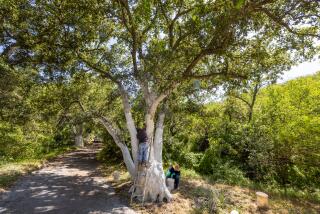Monarchs: Handle With Care
- Share via
Santa Barbara County officials are proceeding with exemplary caution and care in reviewing the potential impact of a massive proposed development on one of the most important winter colonies of Monarch butterflies.
Five separate colonies, including the giant main colony, are at risk. The principal colony ranks among the three largest in western North America. The perils are not imaginary. Two other colonies already have been lost to nearby development between Hollister Avenue and U.S. 101 immediately north of the proposed development in the Ellwood area of Goleta.
The 255-acre tract under consideration lies west of Isla Vista and the Ocean Meadows Golf Course, between Isla Vista and the Sandpiper Golf Course, on a splendid coastal bluff. Under the county master and coastal plans, provision is made for development of 300 dwellings on the site. Those plans also provide for the strict protection of the Monarchs. The development plan now under consideration appears to go beyond the density provided by the master plan, proposing 240 dwelling units and, in addition, a 390-room resort hotel complex. Scientists do not know precisely how adequate protection of the butterfly sites will be, regardless of the extent of the development.
This particular Monarch site is of “immeasurable scientific value,” according to Chris Nagano, who led efforts to tag and trace the incredible migration of Monarchs when he was on the scientific staff of the Los Angeles County Natural History Museum. “We know more about this site than probably any other in western North America,” Nagano commented. “During the last three years--four wintering seasons--we have tagged some 25,000 Monarchs there, and have also collected a tremendous amount of data on such factors as butterfly clustering patterns within the roosts. This gives information on how the insects react to changing air temperature, wind and humidity levels. All of this is being used to protect other wintering colonies in California.” Nagano is convinced that additional studies of two or three years are required to work out a detailed protection plan because of the complexity of calculating the impact and interrelationship among weather, physical environment, wind patterns and plantings.
Santa Barbara County officials are welcoming the collaboration of scientists like Nagano to make sure they succeed in their commitment to protect the Monarch colonies. That is reassuring.






